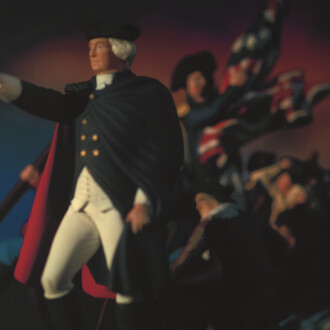With Made in Holland: 400 years a global brand, the Princessehof presents a high-profile exhibition on four Dutch success stories: Delft Blue, Maastricht pottery, Art Nouveau ceramics and Dutch Design. By means of impressive flower pyramids, colourful Boerenbont, popular Gouda pottery and idiosyncratic works by designers like Maarten Baas visitors will discover how the Netherlands became a global player in the field of ceramics.
Everyone knows Dutch Design, which is also extremely popular outside the Netherlands. This phenomenon has a long tradition. From Delft Blue to Art Nouveau, Dutch manufacturers have produced beautiful ceramics and enjoyed worldwide success with them for centuries. The exhibition not only includes the most beautiful objects, but also explains how Dutch producers incorporated foreign influences for their own success.
Around 1600, the VOC introduced Chinese porcelain to the Netherlands. From the moment they arrived in the Netherlands, these expensive blue-and-white dishes and bowls were extremely popular. Dutch manufacturers imitated Chinese porcelain in painted earthenware. Many of these factories were located in Delft, hence the name: Delft Blue. The quality of the pottery was so high that it was exported in abundance to the rest of Europe. The English queen Mary Stuart was a keen patron and collector. The exhibition includes spectacular flower holders, ornate terrines and complete garnitures. Painted tiles were also exported on a large scale. An impressive tile panel, consisting of no less than 585 tiles, illustrates this trade.
In the 19th century, the Maastricht entrepreneur Petrus Regout became the first major industrialist in the Netherlands. He is the ‘godfather’ of the colourful transfer-printed pottery and of Boerenbont, but these products were not his inventions. He imported material, personnel and machines from England, enabling him to produce the well-known pottery on a large scale. In the exhibition visitors will see the English examples, the popular Maastricht pottery itself, and also the adaptations Regout made to the models and decorations in order to conquer the Japanese and Islamic markets.
Rozenburg’s eggshell porcelain stole the show at the 1900 Paris World Exhibition. This manufacturer from The Hague introduced a porcelain there that was so thin that it allowed light through. In addition, the elegant bottles, vases and services were beautifully decorated with representations of flowers and animals in a style that was emerging strongly at the time. From 1915 onwards Plateelbakkerij Zuid-Holland (PZH) managed to conquer the American market with Gouda pottery. Vases, plates, clocks, candlesticks and clogs show the characteristic matt-glaze layer and the motifs inspired by Persian ceramics and Greek-Cypriot pottery.
At the end of the last millennium, Dutch designers once again managed to cause a worldwide sensation. This time with Dutch Design, which is characterised by minimalism, unconventional solutions and a sense of humour. A teapot shaped as a skull and a gigantic vase for a small plant show this playful attitude. Contemporary flower pyramids confirm that the centuries-old tradition of Delft Blue is also a source of inspiration. Recently, designers have been combining old crafts with the latest technologies. Ceramics, for example, are processed with a gas burner or even 3D-printed.
More than 700 loans from all over Europe are coming to Leeuwarden for the exhibition. The museum's own collection is supplemented with masterpieces from the National Museum in Gdańsk, the Museum für Kunst und Gewerbe in Hamburg, the Museum of Applied Art in Vienna, the Royal Museums of Fine Art in Brussels and various private collections. Paul Toornend is responsible for the exhibition design.
A team of specialists was appointed to carry out research for the exhibition. This research has revealed important new insights into the export of Dutch ceramics over the past four centuries. The exhibition will be accompanied by a richly illustrated publication focusing on the global success of Dutch ceramics over 400 years.
De tentoonstelling Made in Holland: 400 jaar wereldmerk is onderdeel van Leeuwarden-Fryslân Culturele Hoofdstad van Europa 2018 en wordt mede mogelijk gemaakt door de presenting partners van LF2018: ING, Arriva en Leeuwarder Ondernemersfonds. De tentoonstelling wordt ondersteund door Het Margarethe Petronella Fonds, Turing Foundation, Mondriaan Fonds, Fonds 21, Ottema-Kingma Stichting, Club Céramique, Stichting Van Achterbergh-Domhof, Stichting Het Nieuwe Stads Weeshuis, Vrienden van het Princessehof, Stichting Herbert Duintjer Fonds, Stichting Juckema-Sideriusfonds en Boelstra Olivier Stichting.
















